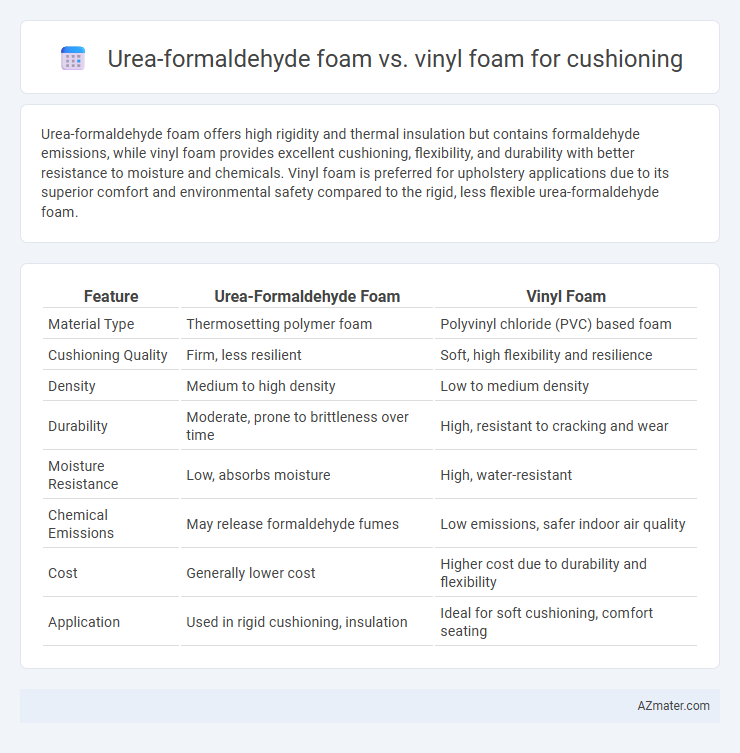Urea-formaldehyde foam offers high rigidity and thermal insulation but contains formaldehyde emissions, while vinyl foam provides excellent cushioning, flexibility, and durability with better resistance to moisture and chemicals. Vinyl foam is preferred for upholstery applications due to its superior comfort and environmental safety compared to the rigid, less flexible urea-formaldehyde foam.
Table of Comparison
| Feature | Urea-Formaldehyde Foam | Vinyl Foam |
|---|---|---|
| Material Type | Thermosetting polymer foam | Polyvinyl chloride (PVC) based foam |
| Cushioning Quality | Firm, less resilient | Soft, high flexibility and resilience |
| Density | Medium to high density | Low to medium density |
| Durability | Moderate, prone to brittleness over time | High, resistant to cracking and wear |
| Moisture Resistance | Low, absorbs moisture | High, water-resistant |
| Chemical Emissions | May release formaldehyde fumes | Low emissions, safer indoor air quality |
| Cost | Generally lower cost | Higher cost due to durability and flexibility |
| Application | Used in rigid cushioning, insulation | Ideal for soft cushioning, comfort seating |
Introduction to Urea-Formaldehyde Foam and Vinyl Foam
Urea-formaldehyde foam is a rigid, thermosetting material commonly used in insulation and cushioning applications due to its excellent compressive strength and thermal resistance. Vinyl foam, also known as PVC foam, is a flexible, closed-cell cushioning material prized for its durability, moisture resistance, and cushioning properties in automotive and marine seating. Both foams offer unique mechanical and chemical properties tailored to specific cushioning needs, with urea-formaldehyde foam favoring structural support and vinyl foam providing enhanced comfort and resilience.
Chemical Composition and Manufacturing Processes
Urea-formaldehyde foam is composed of polymerized urea and formaldehyde resins, formed through a condensation reaction that creates a rigid, thermosetting matrix, whereas vinyl foam primarily consists of polyvinyl chloride (PVC) or vinyl acetate copolymers produced via polymerization and foaming processes to achieve a flexible structure. The manufacturing of urea-formaldehyde foam involves mixing liquid resin precursors followed by foaming and curing under controlled temperature and humidity to attain hardness and dimensional stability. Vinyl foam is produced by incorporating blowing agents into the polymer mixture, then heat or chemical activation generates gas bubbles, resulting in a softer, more pliable cushioning material suited for impact absorption.
Cushioning Performance and Comfort Levels
Urea-formaldehyde foam offers moderate cushioning performance with a firmer feel, making it less effective for prolonged comfort compared to vinyl foam. Vinyl foam provides superior cushioning due to its higher elasticity and resilience, resulting in enhanced comfort levels and better pressure distribution. The denser structure of vinyl foam also contributes to improved durability and sustained support over extended use.
Durability and Lifespan Comparison
Urea-formaldehyde foam exhibits moderate durability with a typical lifespan of 5 to 10 years, making it suitable for budget-friendly cushioning applications but prone to degradation under moisture and heat exposure. Vinyl foam outperforms in durability, offering resistance to environmental factors such as water, chemicals, and UV radiation, with a lifespan extending beyond 15 years in standard use conditions. The superior wear resistance and dimensional stability of vinyl foam contribute to its preference in premium cushioning products requiring long-term performance.
Environmental Impact and Sustainability
Urea-formaldehyde foam releases formaldehyde gas, a known carcinogen that contributes to indoor air pollution and environmental toxicity, raising significant sustainability concerns. Vinyl foam, while more stable chemically, is derived from PVC, a plastic with a high environmental footprint due to its chlorine content and challenges in recycling, leading to persistent landfill accumulation. Sustainable cushioning alternatives often prioritize bio-based foams or recycled materials to reduce harmful emissions and support eco-friendly disposal.
Health and Safety Considerations
Urea-formaldehyde foam releases formaldehyde gas, which can cause respiratory irritation and long-term health risks, making it less safe for indoor cushioning applications. Vinyl foam, also known as PVC foam, generally emits fewer VOCs and poses a lower risk of toxic off-gassing, enhancing indoor air quality and occupant safety. When choosing cushioning materials, prioritizing low-emission foams such as vinyl reduces exposure to harmful chemicals and supports healthier environments.
Cost Analysis and Market Availability
Urea-formaldehyde foam offers a lower production cost due to inexpensive raw materials and widespread manufacturing processes, making it a budget-friendly option for cushioning applications. Vinyl foam, while typically more expensive because of its durable polymer composition and complex production, provides enhanced longevity and resistance to moisture. Market availability favors urea-formaldehyde foam in cost-sensitive industries due to mass production in regions with abundant formaldehyde supply, whereas vinyl foam is preferred in premium cushioning markets where performance justifies higher investment.
Applications in Various Industries
Urea-formaldehyde foam is widely utilized in insulation and packaging due to its rigid structure and excellent thermal properties, making it a preferred choice for the construction and electronics industries. Vinyl foam offers superior flexibility, durability, and moisture resistance, which are critical for cushioning in automotive seating, footwear, and medical device applications. Both foams provide specialized cushioning solutions tailored to specific industrial needs, with urea-formaldehyde foam excelling in structural support and vinyl foam in comfort and resilience.
Maintenance and Care Requirements
Urea-formaldehyde foam requires careful maintenance to prevent moisture absorption that can lead to degradation and odors, making regular ventilation and humidity control essential. Vinyl foam is more resistant to moisture and easier to clean with surface wipes, reducing the need for intensive upkeep and extending the cushioning's lifespan. Proper care for vinyl foam involves avoiding harsh chemicals, while urea-formaldehyde foam demands stricter environmental conditions to maintain structural integrity and comfort.
Summary: Choosing the Right Foam for Cushioning
Urea-formaldehyde foam offers superior rigidity and thermal insulation but lacks flexibility, making it less ideal for cushioning applications requiring softness and resilience. Vinyl foam provides excellent elasticity, durability, and impact absorption, ensuring comfort and long-lasting support in cushioning products. Selecting vinyl foam is optimal for cushioning due to its balance of softness and structural integrity.

Infographic: Urea-formaldehyde foam vs Vinyl foam for Cushioning
 azmater.com
azmater.com